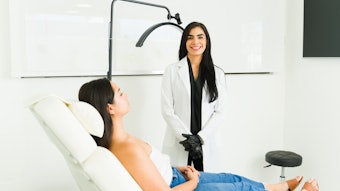
When it comes to revealing a person‟s age, hands down, the back of the hand is more telling than the face and neck. Fortunately, dermatologists are applying new technologies to add volume to the hand as well as remove dark brown “age spots” to reverse these telltale signs of aging.
At the American Academy of Dermatology's Summer Academy Meeting 2011 in New York, dermatologist Dee Anna Glaser, MD, FAAD, director of cosmetic and laser surgery, vice-chairman and professor, department of dermatology at Saint Louis University in St. Louis, presented the latest advances in treating the aging hand, including restoring volume with the use of fillers or a patient‟s own fat and improving texture and overall skin tone with new laser technologies.
“As we age, our hands tend to lose their firmness and volume and the veins and tendons become more pronounced,” says Glaser. “In addition, changes in texture where the skin appears crinkled or is marked with spots, commonly called liver spots or age spots, are the hallmarks of an aging hand.”
As more individuals become conscious of how their hands may disproportionately show their age, Glaser explained that dermatologists now are applying rejuvenation techniques to the hand that have long been successful in treating the face. While these techniques are approved by the U.S. Food and Drug Administration for treating the face, they are not yet approved for use on the hand.
Filling the void with fillers
Glaser discussed how fillers have been used for years to restore volume loss in the face, specifically to the cheek, to smooth the crease that forms along the bottom of the nose to the corners of the mouth. Applying a similar approach, dermatologists now are using fillers to re-establish fullness in the hands.
“Fillers are a great option to rebuild volume and add shape to the hand when a patient has thin, sunken skin—giving the appearance of raised veins and tendons,” says Glaser. “The fillers add volume to the back of the hand, lifting the skin and diminishing the appearance of the veins and tendons to provide a smoother, more youthful appearance.”
Injecting fillers into the back of the hand is an in-office procedure lasting about 20 to 30 minutes that requires no anesthetic. Glaser explained that while some patients may experience slight bruising, the injections offer immediate results and typically last for about a year.
While the use of fillers is a one-step process that is more widely employed, Glaser noted that there are circumstances when a patient‟s own fat is used to build volume in the hand. For example, if a patient already is scheduled for liposuction, the fat that is removed during the liposuction procedure subsequently can be injected into the hand to rebuild the lost shape.
Lasers target texture and pigment changes
In addition to treatments to achieve a plumper, smoother hand, Glaser discussed the use of new laser technologies for treating uneven skin tone and texture as well as common pigmentation changes associated with aging.
Similar to rejuvenation of the face, fractional lasers improve skin tone and smooth fine lines on the hand by targeting small sections deep within the skin. Because the laser is only treating a small section of the hand, surrounding skin is left untreated and helps stimulate healing.
Following this type of laser treatment, patients should expect the skin to turn red, resembling sunburn, for about a week to 10 days and then increasingly improve in appearance. Depending on the patient, three to six treatments with the fractional laser may be needed to achieve the desired results.
To treat the dark brown spots that result from years of UV exposure, Glaser utilizes pigment specific lasers that deliver a beam of light that penetrates the skin‟s surface to treat the affected area of the hand. After treatment, patients can expect the brown spots to appear darker for about a week, after which they will lightly scab, fall off and then turn pink as the skin begins to heal. Strict sun avoidance and protection is needed following most laser treatments. Glaser added that one to two treatments with this type of laser may be needed to improve these common pigmentation problems.
“The hands are often overlooked because we put so much emphasis on our face, but our hands can be even more susceptible to the effects of aging,” says Glaser. “With continued advances in dermatology, there are many options available to patients to minimize the appearance of an aging hand. But I always remind my patients that prevention truly is the best medicine, so don‟t forget to apply a broad-spectrum sunscreen with an SPF 30 or more to all exposed areas of skin, including the backs of your hands.”










